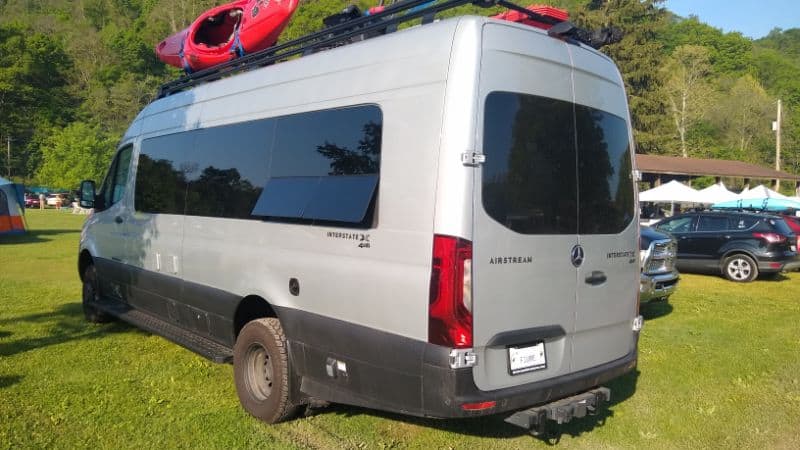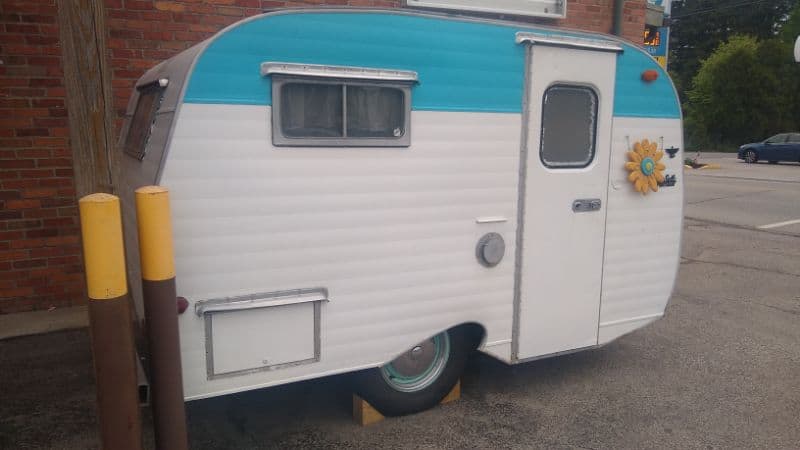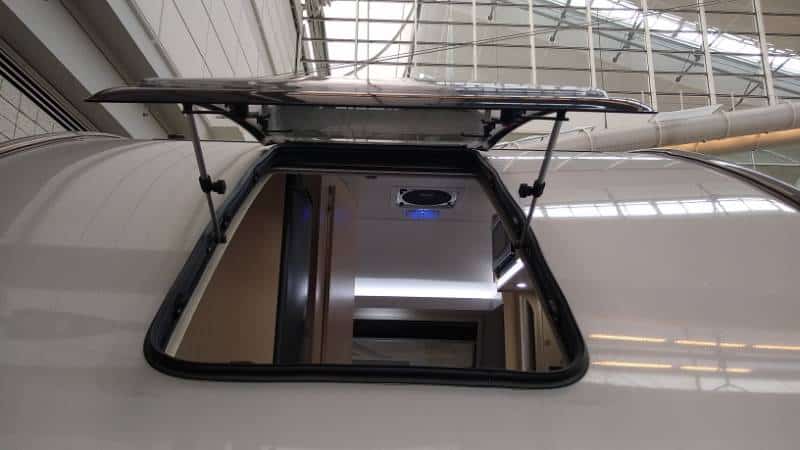I’m answering all the odds-and-ends questions I’ve heard about RV windows! If you’ve ever wondered whether frameless RV windows are worth the price or what’s an RV window clamp ring, then read on.
Note: This post focuses on RV sidewall and rear windows, not windshields or skylights.
What Type of Glass Is Used in RV Windows?
Most glass windows and doors on RVs, motorhomes and campers are made from tempered glass, also known as safety glass.
Tempered glass has been rapidly cooled to generate internal stresses. It’s incredibly strong, but when cracked, it crumbles into pebble-sized pieces. The rough pebbles are safer than large, sharp shards.
RV windshields are made from laminated glass, which is two layers of tempered glass glued by a sandwiched plastic sheet. When the glass fractures, it stays in place, bonded to the sheet. In the event of a crash, it stops pieces of glass from flying into occupants like shrapnel.
Some double-pane RV windows are made from acrylic, which is plastic, not glass. These are commonly called “Euro-style” or “bubble” insulated windows. Acrylic cracks and splits; it does not easily shatter.
Who Are Common RV Window Manufacturers?
Major RV window manufacturers include:
- Lippert
- Dometic
- Hehr
- Cleer Vision
- Kinro
Aftermarket supplies include Pelland Enterprises, All-Rite, and Motion Windows.
If you’re hunting for a particular window, I recommend soliciting help from your RV manufacturer.
Can You Put Regular Windows In an RV?
Ehh .. not really.
The only time you’ll see residential-style windows in an RV is on Park Model RVs (PMRV), which are actually built to a different code than campers and motorhomes. They aren’t designed for mobile living.
The main concern is that residential double-pane windows will break down and fog up in an RV due to the shock and vibration. See my article on double-pane windows for more information on this.
The other hitch is that residential windows are designed to be installed behind siding, which RVs don’t use …
Plus, they cost a lot more.
And they aren’t tinted.
Get the point?
Are Frameless RV Windows Better?
Frameless windows in an RV are mostly a cosmetic choice. They’re an attractive, modern, streamlined alternative to classic framed RV windows, which (IMHO) don’t look much nicer than the windows on a horse trailer.
Many frameless windows are double-pane, which has significant advantages over single-pane windows. They keep out the weather and the noise! And most come with a dark UV tint.
A frameless window is a single large pane of glass hinged at the top, called an awning window. This means they can be opened during light rain – the pane will shed the water!

Unfortunately, frameless windows usually can’t be opened very far, and ventilation is rather poor. Some people prefer classic framed windows because of the superior cross breeze when opened.
What Is an RV Window Clamp Ring?
Except for windshields and frameless windows, most RV windows mount with a clamp ring.
It’s pretty simple. The window itself mounts on the outside wall. Inside, there’s a matching clamp ring. You screw the clamp ring to the window flange, and the screw draws the two together. This sandwiches the wall between the window frame and clamp ring, which forms a waterproof seal.

What Is an RV Slider Window?
“Sliders” are the bread and butter of RV windows. These are framed glass windows with panels that slide open for ventilation.

Sliders come in three styles:
- Horizontal slider
- Vertical slider
- T-Slider: Combination of a fixed pane and sliding pane window
What Is a Radius RV Window?
A “radius” RV window simply means a window with rounded corners. This is what almost all modern RVs use. Vintage RVs (1980s and earlier) used square windows, with mitered corners.

Should You Caulk Around RV Windows?
Yes, you absolutely should! (unless it’s a frameless or bubble acrylic window).
Conventional framed RV windows rely on two seals to keep out water: 1) a butyl gasket between the wall and the frame flange, and 2) a cap sealant around the perimeter. It’s your job to maintain that cap sealant.
So yes, every year, inspect and/or replace the cap sealant around the perimeter of your windows.
Pro Tip: Be particularly proactive about this maintenance if your RV is under warranty! Keep reliable records, or else manufacturers might dismiss a leak as a “lack of preventative maintenance.”
What Is the Best Sealant for RV Windows?
Lucky for you, I’ve answered this question in depth elsewhere!
- Sealing the Outside of Your RV – Meet the Family (of Caulks and Sealants)
- My Favorite RV Caulks and Sealants (Not Just Another Schmoozy Amazon List!)
In short, I recommend using a non-sag RV window sealant. Geocel Proflex RV is my favorite.
While silicone isn’t quite the devil you’ve been led to believe, I’d stay away from most retail-sold silicone sealants. These are nowhere near the quality of industrial-grade silicone, and they’re infamous for peeling off and being difficult to replace.
Do RV Windows Have Weep Holes?
All framed RV windows have weep holes, yes. These usually are two small rectangular slots at the bottom of the frame. If water leaks between the window pane and rubber frame gasket, the water should weep out of the bottom holes.
This does NOT protect against leaks around the flange! If rain enters behind the window flange, it will leak into your camper! You need to re-seal the flange with a non-sag sealant, as I mentioned above, and maybe consider re-installing the window with new butyl tape.
Awning-style and frameless windows generally do not have weep holes. That’s because the glass or acrylic pane is top-hinged and closes against a hidden rubber gasket. No need for weep holes.
Do RV Windows Have Screens?
Yes. The exceptions are picture windows, which are fixed and don’t open, and egress windows, which don’t have screens for safety reasons.
But most sliders have screens built into them. Frameless windows have separate screen/shades, which are mounted directly to the wall.
What Is An Egress Window?
Per the fire code, most RVs are required to have egress windows. These are emergency escape windows. Most are quite large and are in bedroom-accessible locations. Many are awning-style, but some are enormous sliders.
Typically, egress windows will have a red latch or red sticker indicating them as such.

How Do You Keep the Sun Out of RV Windows?
Are you wondering how to cover your RV windows? Getting too hot in the summer? Well, there’s an entire cottage industry around this problem!
Your RV may come with curtains, shades, or blinds. Unfortunately, many simple curtains don’t do a good job keeping out the sunlight – and its heat!
The recommended solution is to install Reflectix window covers. Many people upholster Reflectix in cotton duck cloth and sew on Velcro mounting circles. They look great and can be removed and installed in two seconds!
If you don’t want to make your own, there are many companies selling similar products. You may have to send in your own measurements and wait 2-4 weeks until they arrive in the mail, however.
Will Reflectix Damage RV Windows?
You’ve likely heard the warning that Reflectix can damage or warp glass windows.
This is true … theoretically. You see, Reflectix essentially “bounces” off sunlight. So sunlight passes through the window once, where some of it gets absorbed as heat. Then it hits the Reflectix and bounces back through the window, where more light is absorbed as heat. So it’s a double-whammy for heat gain.
Translation: You’ll bake your windows. They’ll get so hot you can’t touch them with your bare skin; you’ll burn. And at those temperatures, some windows have been known to shatter, especially if water or rain spills on them.
With that said, 99.99% of the time, nothing happens. I, like most RV owners, have used Reflectix for years, and while I have singed my skin a few times, the windows are fine.
How Do You Black Out RV Windows?
Most RV windows have only a medium tint. The tint keeps out prying eyes, but not the sun! And with egress windows required in or near sleeping areas – well, you see how this plays out!
If you’re tired of waking up with third-degree blisters from the sunlight on your face, you need blackout shades. Few RVs come standard with black-out shades, so you’ll need to add your own.
You can either get blackout shades or curtains. Many RVers prefer curtains. If you don’t like the look of black curtains (reminds you of a funeral, doesn’t it?) then one option is to order or upholster double-sided curtains.
How Do You Winterize RV Windows?
Wondering how you insulate RV windows for winter?
Foam inserts work best. You can mess around with upholstered Reflectix covers or heavy draperies, but I’m telling you, nothing works better than a 1” thick foam insert block. Upholster, wrap, or paint to your satisfaction.
The tricky decision in winter is to figure out whether the heat you’re gaining from sunlight is greater than the heat you’re losing through the glass. In direct sun, I’d take the foam covers off.
Can I Tint My RV Windows?
Yes. RV windows are made of the same safety glass as older automobiles. The same aftermarket tinting film techniques apply to both.
However, due to the time involved, most people choose not to un-install the window for a full pane tint.
Can You Replace Windows in an RV?
Yes, you can. If you’re a moderately handy person, you can probably replace the sidewall windows in your RV.
However, you will need to find an exact match for your existing window, which can be a challenge. Reach out to the manufacturer and ask for specifications. Or contact a specialty window manufacturer like Pelladent.
RV windows come in many styles, and the installation is slightly different for each. Be prepared to spend some time on YouTube if this is your first attempt!
What Are Euro-Style Bubble Windows?

I talk more about Euro-style windows in my guide to double-pane windows. Read that article for more info 🙂
Leave a Reply